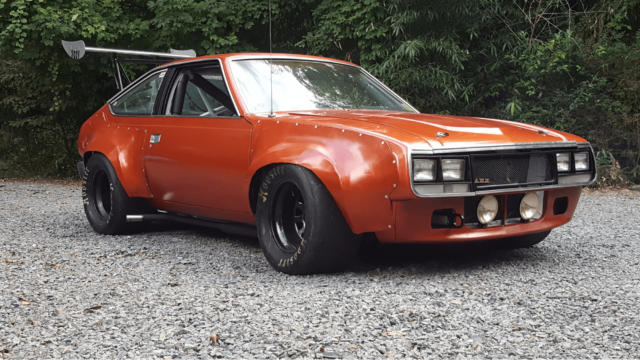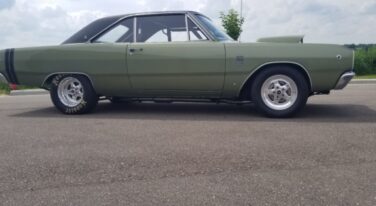![[GALLERY] An AMC Sprint with Attitude AMC, Sprint, Gallery, Hot Rod](https://www.racingjunk.com/news/wp-content/uploads/2022/03/image7-min-678x381.png)
[GALLERY] An AMC Sprint with Attitude
Click Here to Begin Slideshow
With the intention of blending street rat, commuter rod, and low-budget pro tourer, Michael bought a 1980 AMC spirit with a hundred-dollar bill.
The grander aim was participating in the GRM Challenge. For those not familiar with it, it’s a competition in which entrants have to build a car and compete in autocross, drag, and show competitions. That list of competitions is nothing new, but the cars expected to do this usually aren’t quite so cost-restricted. The trickiest bit of building a GRM Challenge car is capping the total build costs at 2000 dollars.
Most of Mike’s money was being spent on improving reliability, safety, and suspension. The brakes were adequate for what the car had to do, but the suspension wasn’t, so Mike upgraded to ADDCO’s 1” front sway bar and ¾” rear bar, Prothane bushings, Bilstein shocks, as well as dearched and stiffened rear leaves. The suspension total: $600.
He had the engine stripped of its smog equipment before he had a hybrid carter 2BBL built. Along with a recurved distributor, 2 ½” exhaust, electric fan, he fulfilled his plan of simplifying the motor for this sort of performance. Total on the motor: $200.
With a donor Lincoln Town Car he grabbed for $410, Michael had a running, driving, shifting 5.0 and an AOD transmission. Shortly thereafter, he met another tinkerer changing directions on a Mustang build looking for a tidy 5.0. He offered a .30-over 302 with a hydraulic cam, GT40P heads, an Edelbrock RPM intake, an AED 750 carb, and Mallory ignition. All it cost was $300, though the reason was that it was largely unassembled. With a lot of time and effort, Michael turned it into this:
To spruce up the interior, he used a pair of aluminum; turning the car into a two seater. The rear was finished with a flat bed, and the rear set made into storage pockets with a sub enclosure. The total: $90.
But the biggest hurdle covered up until this point was the bodywork. Predictably, it had seen better days and the touch up, the fitting of the cage, the coat of enamel took Michael and his friends, some of whom were hired simply to drink beer and provide comic relief, several weekends. Seeing the way the primer had transformed the copper AMC into something genuinely pretty, they shot the motor in a tasty shade quite close to Ford Blue.
The follow up jobs weren’t quite so sweet. The headers, for instance, looked like an easy job, but they required a pack of cigarettes, a pot of coffee, and a few swift blows from a sledgehammer to shoehorn ‘em in their new resting place.
When it came time to fit a nice set of shoes, Michael snagged a set of 15x10” wheels from a rock climber, wrapped them in a set of Hoosier slicks from a circle track car, and planned out how he’d get the bodywork to fit over the new footwork.
That was put aside for some time as the first event was approaching. Once on track, the short wheelbase, punchy powerplant, and wide footprint won Michael’s heart. Much faster than he was capable of driving at the time, the AMC encouraged him to drive hard in Texas heat. Come the end of the day, he was drenched in sweat, the gearbox was leaking from every seal, and the distributor was weeping. Still, despite the exhaustion and the long weekend of wrenching ahead, Michael was elated.
For a car he had expected to be mid-pack at best, it had front-running pace. It trail braked beautifully, put most of its power down without wheelspin, and barely required any heavy prod of the middle pedal unless he’d gone off-line.
Back in the garage the following weekend, he turned his attention to the cosmetic side of things. Some trim touch-up, another coat of paint, and a set of homemade flares made the wing. For the faster autocrosses later down the road, he had to fit a wing.
With over ten years spent putting this little monster together, Michael and his friends are relieved to be able to finally put this AMC through its paces. For those curious about the way this modest AMC—one which came in a couple hundred underneath the $2000 limit—its exploits are covered in detail in this thread. Let’s hope such an affordable build, despite the fifteen years it took to finish, will motivate others to try their hand at a little cone carving.
Click Here to Begin Slideshow
With the intention of blending street rat, commuter rod, and low-budget pro tourer, Michael bought a 1980 AMC spirit with a hundred-dollar bill.
The grander aim was participating in the GRM Challenge. For those not familiar with it, it’s a competition in which entrants have to build a car and compete in autocross, drag, and show competitions. That list of competitions is nothing new, but the cars expected to do this usually aren’t quite so cost-restricted. The trickiest bit of building a GRM Challenge car is capping the total build costs at 2000 dollars.
Most of Mike’s money was being spent on improving reliability, safety, and suspension. The brakes were adequate for what the car had to do, but the suspension wasn’t, so Mike upgraded to ADDCO’s 1” front sway bar and ¾” rear bar, Prothane bushings, Bilstein shocks, as well as dearched and stiffened rear leaves. The suspension total: $600.
He had the engine stripped of its smog equipment before he had a hybrid carter 2BBL built. Along with a recurved distributor, 2 ½” exhaust, electric fan, he fulfilled his plan of simplifying the motor for this sort of performance. Total on the motor: $200.
With a donor Lincoln Town Car he grabbed for $410, Michael had a running, driving, shifting 5.0 and an AOD transmission. Shortly thereafter, he met another tinkerer changing directions on a Mustang build looking for a tidy 5.0. He offered a .30-over 302 with a hydraulic cam, GT40P heads, an Edelbrock RPM intake, an AED 750 carb, and Mallory ignition. All it cost was $300, though the reason was that it was largely unassembled. With a lot of time and effort, Michael turned it into this:
To spruce up the interior, he used a pair of aluminum; turning the car into a two seater. The rear was finished with a flat bed, and the rear set made into storage pockets with a sub enclosure. The total: $90.
But the biggest hurdle covered up until this point was the bodywork. Predictably, it had seen better days and the touch up, the fitting of the cage, the coat of enamel took Michael and his friends, some of whom were hired simply to drink beer and provide comic relief, several weekends. Seeing the way the primer had transformed the copper AMC into something genuinely pretty, they shot the motor in a tasty shade quite close to Ford Blue.
The follow up jobs weren’t quite so sweet. The headers, for instance, looked like an easy job, but they required a pack of cigarettes, a pot of coffee, and a few swift blows from a sledgehammer to shoehorn ‘em in their new resting place.
When it came time to fit a nice set of shoes, Michael snagged a set of 15x10” wheels from a rock climber, wrapped them in a set of Hoosier slicks from a circle track car, and planned out how he’d get the bodywork to fit over the new footwork.
That was put aside for some time as the first event was approaching. Once on track, the short wheelbase, punchy powerplant, and wide footprint won Michael’s heart. Much faster than he was capable of driving at the time, the AMC encouraged him to drive hard in Texas heat. Come the end of the day, he was drenched in sweat, the gearbox was leaking from every seal, and the distributor was weeping. Still, despite the exhaustion and the long weekend of wrenching ahead, Michael was elated.
For a car he had expected to be mid-pack at best, it had front-running pace. It trail braked beautifully, put most of its power down without wheelspin, and barely required any heavy prod of the middle pedal unless he’d gone off-line.
Back in the garage the following weekend, he turned his attention to the cosmetic side of things. Some trim touch-up, another coat of paint, and a set of homemade flares made the wing. For the faster autocrosses later down the road, he had to fit a wing.
With over ten years spent putting this little monster together, Michael and his friends are relieved to be able to finally put this AMC through its paces. For those curious about the way this modest AMC—one which came in a couple hundred underneath the $2000 limit—its exploits are covered in detail in this thread. Let’s hope such an affordable build, despite the fifteen years it took to finish, will motivate others to try their hand at a little cone carving.
Click Here to Begin Slideshow



![[Gallery] Okolona Street Rods Kentuckiana V Foundation Car Show](https://www.racingjunk.com/news/wp-content/uploads/2022/04/IMG_0774-e1650040587750-376x206.jpg)
![[Gallery] Road Rats Car Show](https://www.racingjunk.com/news/wp-content/uploads/2022/05/2A-e1651770667920-376x206.jpg)


Leave a Reply